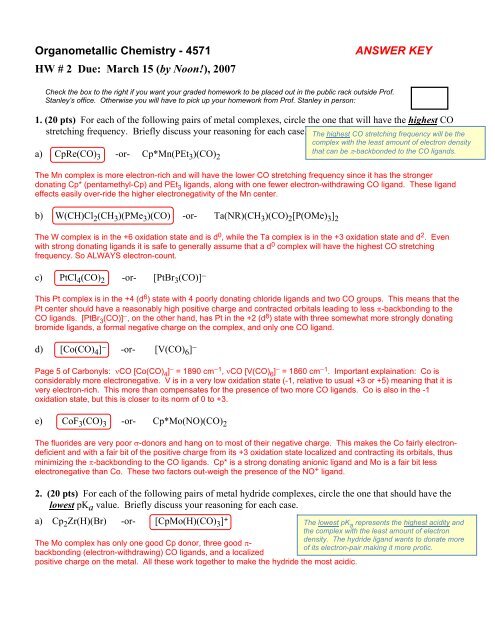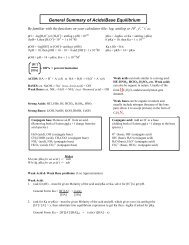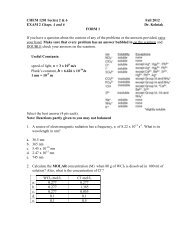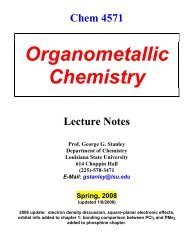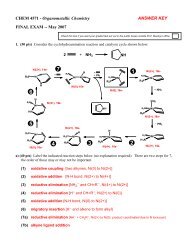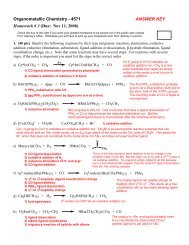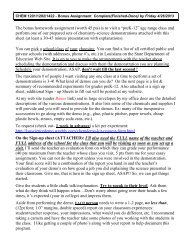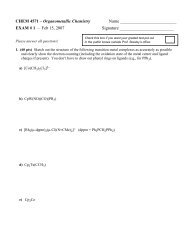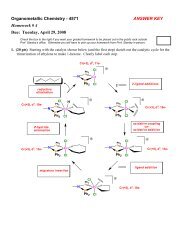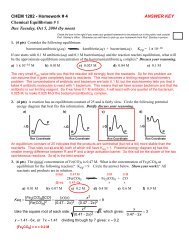Homework #2-Answers - Chemistry
Homework #2-Answers - Chemistry
Homework #2-Answers - Chemistry
You also want an ePaper? Increase the reach of your titles
YUMPU automatically turns print PDFs into web optimized ePapers that Google loves.
Organometallic <strong>Chemistry</strong> - 4571<br />
HW # 2 Due: March 15 (by Noon!), 2007<br />
ANSWER KEY<br />
Check the box to the right if you want your graded homework to be placed out in the public rack outside Prof.<br />
Stanley’s office. Otherwise you will have to pick up your homework from Prof. Stanley in person:<br />
1. (20 pts) For each of the following pairs of metal complexes, circle the one that will have the highest CO<br />
stretching frequency. Briefly discuss your reasoning for each case.<br />
a) CpRe(CO) 3 -or- Cp*Mn(PEt 3 )(CO) 2<br />
The highest CO stretching frequency will be the<br />
complex with the least amount of electron density<br />
that can be π-backbonded to the CO ligands.<br />
The Mn complex is more electron-rich and will have the lower CO stretching frequency since it has the stronger<br />
donating Cp* (pentamethyl-Cp) and PEt 3 ligands, along with one fewer electron-withdrawing CO ligand. These ligand<br />
effects easily over-ride the higher electronegativity of the Mn center.<br />
b) W(CH)Cl 2 (CH 3 )(PMe 3 )(CO) -or- Ta(NR)(CH 3 )(CO) 2 [P(OMe) 3 ] 2<br />
The W complex is in the +6 oxidation state and is d 0 , while the Ta complex is in the +3 oxidation state and d 2 . Even<br />
with strong donating ligands it is safe to generally assume that a d 0 complex will have the highest CO stretching<br />
frequency. So ALWAYS electron-count.<br />
c) PtCl 4 (CO) 2 -or- [PtBr 3 (CO)] −<br />
This Pt complex is in the +4 (d 6 ) state with 4 poorly donating chloride ligands and two CO groups. This means that the<br />
Pt center should have a reasonably high positive charge and contracted orbitals leading to less π-backbonding to the<br />
CO ligands. [PtBr 3 (CO)] − , on the other hand, has Pt in the +2 (d 8 ) state with three somewhat more strongly donating<br />
bromide ligands, a formal negative charge on the complex, and only one CO ligand.<br />
d) [Co(CO) 4 ] − -or- [V(CO) 6 ] −<br />
Page 5 of Carbonyls: νCO [Co(CO) 4 ] − = 1890 cm −1 , νCO [V(CO) 6 ] − = 1860 cm −1 . Important explaination: Co is<br />
considerably more electronegative. V is in a very low oxidation state (-1, relative to usual +3 or +5) meaning that it is<br />
very electron-rich. This more than compensates for the presence of two more CO ligands. Co is also in the -1<br />
oxidation state, but this is closer to its norm of 0 to +3.<br />
e) CoF 3 (CO) 3 -or- Cp*Mo(NO)(CO) 2<br />
The fluorides are very poor σ-donors and hang on to most of their negative charge. This makes the Co fairly electrondeficient<br />
and with a fair bit of the positive charge from its +3 oxidation state localized and contracting its orbitals, thus<br />
minimizing the π-backbonding to the CO ligands. Cp* is a strong donating anionic ligand and Mo is a fair bit less<br />
electronegative than Co. These two factors out-weigh the presence of the NO + ligand.<br />
2. (20 pts) For each of the following pairs of metal hydride complexes, circle the one that should have the<br />
lowest pK a value. Briefly discuss your reasoning for each case.<br />
a) Cp 2 Zr(H)(Br) -or- [CpMo(H)(CO) 3 ] +<br />
The lowest pK a represents the highest acidity and<br />
the complex with the least amount of electron<br />
density. The hydride ligand wants to donate more<br />
The Mo complex has only one good Cp donor, three good π-<br />
of its electron-pair making it more protic.<br />
backbonding (electron-withdrawing) CO ligands, and a localized<br />
positive charge on the metal. All these work together to make the hydride the most acidic.
HW<strong>#2</strong> (2007) – Answer Key 2<br />
b) H 2 Ru(C≡NCH 3 ) 2 (CO) 2 -or- H 2 Ru(PMe 3 ) 2 (CO) 2<br />
Everything is the same except for the :C≡NCH 3 (isocyanide) and :PMe 3 ligands (both neutral). The alkylated<br />
phosphine is the stronger σ-donor (negligible π-acceptor), while the isocyanide is not as strong a σ donor and a better<br />
π-acceptor (see homework assignment # 1). This makes the isocyanide complex less electron-rich and more acidic.<br />
c) Cp 2 V[P(OCF 3 ) 3 ](H) -or- [Cp 2 W(H)] −<br />
The V complex has poor σ-donating phosphites that will be fairly good π-acceptors with the electron-withdrawing CF 3<br />
groups. This will make it easier to dissociate a proton. If the W complex loses a proton it will be dianionic and too<br />
electron-rich.<br />
d) HRh(CO)(PCy 3 ) 2 -or- HCo(CO)(PMe 3 ) 2<br />
The ligands are pretty similar with the PCy 3 being a somewhat stronger σ-donator relative to PMe 3 . Co is more<br />
electronegative than Rh and this also helps make the Co complex the more acidic.<br />
e) [HOs(PMe 3 )(dmpe) 2 ] + -or- HRe(CF 3 ) 2 (CO) 2 [P(OMe 3 ) 3 ] 2<br />
Poor donor ligands coupled with moderate (phosphite) and good π-acceptor (CO) ligands is more important here for<br />
the Re complex than the positive charge on the Os complex which has strong phosphine donor ligands. Six ligands<br />
can override a single charge.<br />
4. (10 pts) Consider Cp 2 Rh 2 [μ-(CF 3 CCCF 3 )](CO)(CNR) shown on page 7 of the Alkene/Alkyne chapter.<br />
The Rh-Rh bond distance is 2.67 Å strongly indicating the presence of a covalent bond between the two<br />
rhodium atoms. (a) (5 pts) show the electron-counting for this complex including Rh oxidation state,<br />
ligand charges, # of e- donated, etc. Only one Rh center needs to be counted since both the CO and<br />
C≡NR ligands are neutral 2e- donors making the complex electronically symmetrical from an electron<br />
counting viewpoint. (b) (5 pts) Why does the alkyne ligand orient parallel to the Rh-Rh bond? From an<br />
organic hybridization and bonding viewpoint how should the “alkyne” be considered? Draw a simple<br />
orbital picture showing how the filled “alkyne” orbitals are overlapping with the empty Rh orbitals (use<br />
the diagram below as a starting point, ignore all other ligands).<br />
a) The electron-withdrawing groups on the alkyne allow it to oxidize each Rh center<br />
by 1e- to put each into the +2 oxidation state (d7) and convert the alkyne into a<br />
dianionic bridging alkene ligand. This is analogous to the alkene example on the<br />
first page of the alkene chapter where the electron-withdrawing cyano groups<br />
allow it to formally oxidize the Pt center and make a σ-coodinated metallocyclopropane<br />
complex.<br />
Rh(+2)<br />
d7<br />
Cp- 6e-<br />
[CF 3 C=CCF 3 ] 2- 2e-<br />
CO (or CNR) 2e-<br />
Rh-Rh 1e-<br />
18e-<br />
b) The 2e- reduction of the alkyne changes the carbon hybridization from sp to sp 2 (double bond like). Each carbon<br />
center now has a sp 2 hybrid orbital in the plane of the double bond with a lone-pair to bond to each Rh center. By<br />
using these stronger σ-donating orbitals the “alkyne” ligand now must orient parallel to the Rh-Rh bond axis.<br />
Remember that ligands with π-systems and σ-lone pairs generally prefer bonding to the metal via the σ-lone pairs.


